Eastern Sandhill Crane Banding Programs
Have you seen a banded Sandhill Crane and would like to find out where and who banded the crane? Cranes are banded with color markers (also known as auxiliary bands) and aluminum bands throughout North America. This page focuses on banding protocols for the Eastern Population of Greater Sandhill Cranes (Grus canadensis tabida), which are found east of the Mississippi River in the United States.
Did you observe a banded Sandhill Crane in the western United States or Canada? Don’t worry, you can report it to the International Crane Foundation as well, and we will forward your sighting to the appropriate organization. If you have a bird in hand and can read the eight-digit number on the aluminum band, you also can report it to the USGS Bird Banding Laboratory.
Report a Banded Sandhill Crane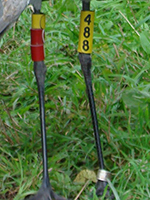
International Crane Foundation, southcentral Wisconsin
Coordinator: Andy Gossens
There is a 3″ band above the tarsal joint on either the left or right leg (either green with white engraved numbers, blue with white engraved numbers or yellow with black engraved numbers). The opposite leg above the tarsal joint has a combination of 1″ color bands (red, green, white, blue or yellow). The aluminum band is either in the color combination opposite the leg with the 3″ band or below the tarsal joint on either leg
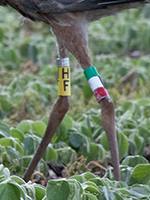
International Crane Foundation, southcentral Wisconsin
Coordinator: Andy Gossens
There is a 2″ yellow band above the tarsal joint on either the left or right leg with black engraved letters. Above the 2″ band is an aluminum band. The opposite leg above the tarsal joint has a combination of 1″ color bands (red, green, white, blue or yellow).
In addition, the International Crane Foundation is banding cranes in the upper Midwest and the northeastern United States to study gene dispersal and has deployed the following six banding schemes:
Eastern Wisconsin
There is a 3″ white band with an attached radio transmitter above the tarsal joint on either the right or the left leg; the other leg has a color combination of three 1″ bands in sky blue, white and/or orange. There is also an aluminum band that is located below the tarsal joint on the leg that holds the radio transmitter.
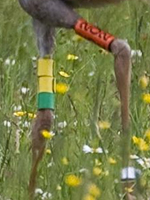
Southcentral Ontario
There is a 3″ orange band with black numbers on one leg and three 1″ color bands (red, green, white, blue or yellow) on the other leg. The aluminum band is below the tarsal joint.
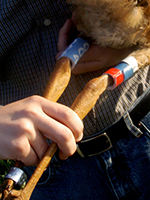
Seney National Wildlife Refuge, Upper Peninsula, Michigan
There is a 3″ light blue band with white numbers on one leg and three 1″ color bands (red, green, white, blue, or yellow) on the other leg. The aluminum band is below the tarsal joint.
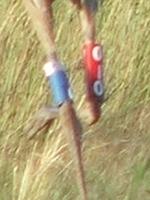
Minnesota and northwestern Wisconsin
There is a 3″ red band with white numbers on one leg and one or two 1″ color bands (red, green, white, blue or yellow) on the other leg. The aluminum band is located above the tarsal joint with the 1″ color bands.
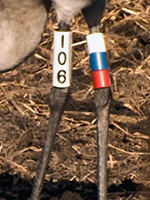
Photo by David Allerton
Southern Michigan
There is a 3” white band with black numbers on one leg and three 1″ color bands (red, green, white, blue or yellow) on the other leg. The aluminum band is below the tarsal joint.
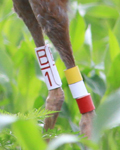
Pennsylvania and New York
There is a 3″ white band with red letters on top and numbers on the bottom with a thin line in between on one leg and three 1″ color bands (red, green, white, blue or yellow) on the other leg. The aluminum band is below the tarsal joint.
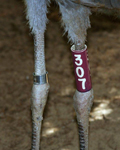
East central Wisconsin
Coordinator: Pat Fisher
There is a 3″ purple band with off-white numbers on one leg above the tarsal joint. The aluminum band is located on the opposite leg above the tarsal joint.
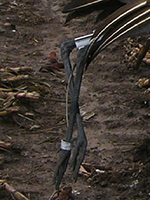
Long Point, Ontario
Coordinator: Scott Petrie
There is a 3″ plain white band (no alpha or numeric code) with flanges for riveting the two halves together and a radio transmitter attached. The aluminum band is located below the tarsal joint.
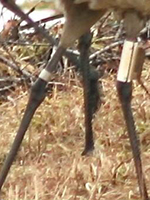
Photo by Jason Huckeba
Northern Ohio
Coordinator: Dave Sherman
There is a 3” white band with a black alpha-numeric code (from Z01 to Z25) with flanges for riveting the two halves together and a radio transmitter attached. The aluminum band is located above the tarsal joint on the leg opposite the 3″ band.
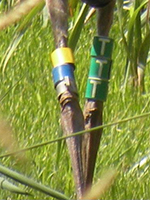
Northern Illinois
Coordinator: Brad Semel
There are three 1″ color bands OR 2 1″ color bands plus an aluminum band on the left leg.
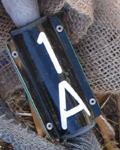
Tennessee
Coordinator: Dave Fronczak
A 3″ black band with white lettering is above the tarsal joint, and the alpha-numeric code, read top to bottom, has a number (from 0 to 9) over a letter (A, C, E, J or K). The band has flanges for riveting the two halves together and a radio transmitter is attached. An aluminum band is below the tarsal joint on the opposite leg.
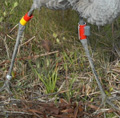
Mississippi Sandhill Crane National Wildlife Refuge, Auxiliary Banding Protocols for the Mississippi Sandhill Crane (Grus canadensis pulla)
Coordinator: Scott Hereford
There have been three basic schemes used for free-flying Mississippi Sandhill Cranes hatched in captivity:
1999–present: There are two 1″ or 1.5″ color bands [blue (light, royal), green (pea, dark), orange, red, white or yellow; a few are gray] above the tarsal joint on one leg, and a 2″ or 3″ color band with attached radio on the other leg above the tarsal joint. The transmitter band consists of two halves that are riveted together. Transmitter band colors may be royal blue, dark green, orange, red, white or yellow. A few are black. Cranes in the same release cohort have the same color transmitter band and the same above-hock 1″ color band on the other leg. The aluminum lock-on band is below the tarsal joint on the same leg as the transmitter band.
1996–1998: 3″ transmitter band with 3-digit number read top to bottom on one leg above tarsal, two 1.5″ color bands on the other leg above tarsal.
1981–1995: 3″ band with 3-digit number read top to bottom on one leg above tarsal joint and a 3″ transmitter band on the other leg above the tarsal joint, with the aluminum band below the tarsal joint.
For cranes hatched in the wild, the aluminum band and a 1″ color band are on one leg above the tarsal joint, and two 1″ color bands or a 2″ transmitter band are on the other leg above the tarsal. No bands were placed below the tarsal on wild-hatched birds.